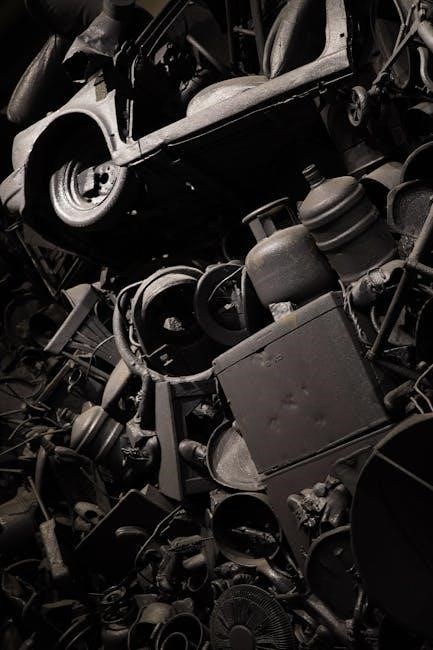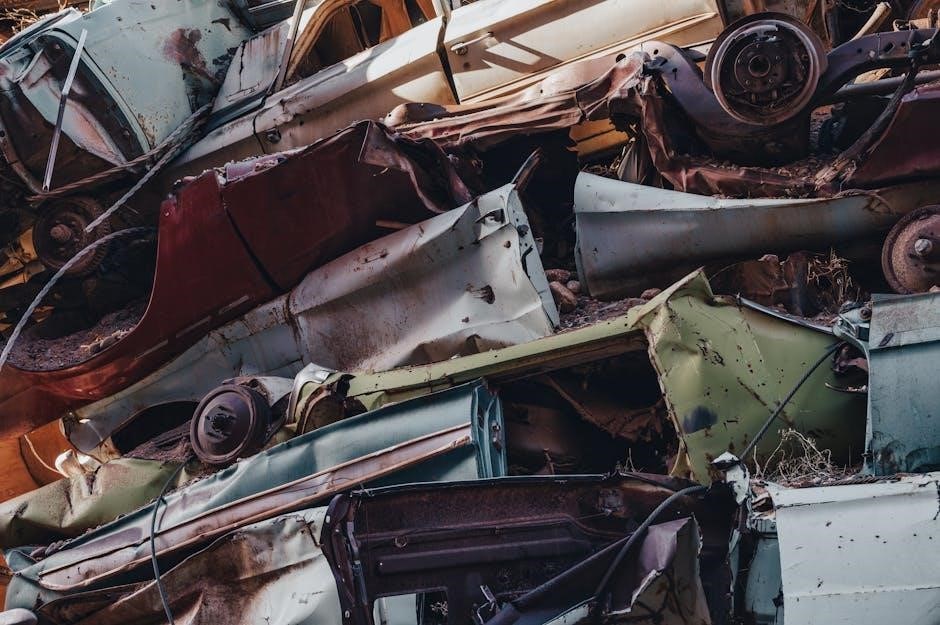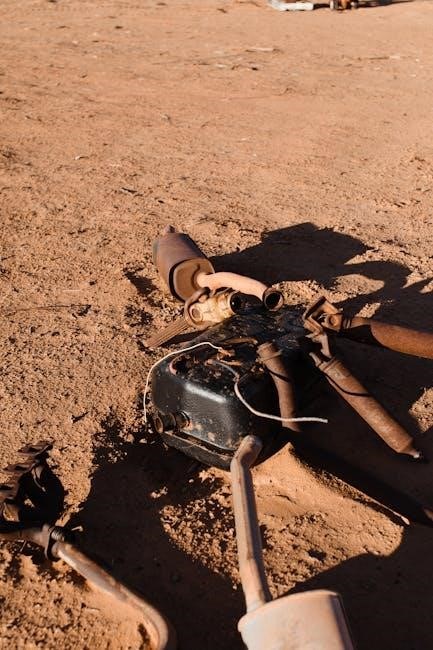Scrap metal identification is crucial for efficient recycling and environmental sustainability. Learning to recognize different metals ensures proper processing and maximizes economic value. This guide provides essential insights for both beginners and experienced scrappers to accurately identify and sort various scrap metals, promoting eco-friendly practices and profitable recycling.

Overview of Scrap Metal Recycling
Scrap metal recycling is a vital process that contributes to environmental conservation and resource efficiency. By reprocessing metals from discarded materials, recycling reduces the need for mining raw materials, lowering energy consumption and greenhouse gas emissions. The industry supports sustainable practices by transforming scrap into reusable resources, benefiting both the economy and the planet. Recycling facilities sort and process metals, separating ferrous and non-ferrous types for proper melting and reuse. This system minimizes landfill waste and preserves natural resources, making it a cornerstone of circular economy principles. Accurate identification of metals ensures efficient processing, highlighting the importance of knowledge in maximizing recycling potential and promoting eco-friendly practices globally.
Importance of Accurate Metal Identification
Accurate metal identification is essential for ensuring safe, efficient, and profitable scrap metal recycling. Correctly identifying metals prevents contamination in recycling streams, which can lead to equipment damage or unsafe processing conditions. It also enables proper segregation of materials, ensuring they are recycled appropriately and reducing environmental harm. Additionally, accurate identification maximizes the value of scrap metals, as different materials have varying market prices. Misidentification can lead to financial losses or safety hazards, such as mixing incompatible metals during melting. By understanding and applying identification techniques, individuals and businesses contribute to a more sustainable and economically viable recycling industry while minimizing risks associated with improper handling of metals.

Methods for Identifying Scrap Metals
Identifying scrap metals involves simple yet effective techniques like magnet tests, visual inspections, and physical property assessments. These methods help determine metal types efficiently for recycling purposes.
The Magnet Test: Ferrous vs. Non-Ferrous Metals
The magnet test is a simple, effective method for distinguishing ferrous and non-ferrous metals. Ferrous metals, such as steel and iron, contain iron and are attracted to magnets, while non-ferrous metals like aluminum, copper, and brass are not. This test is a quick first step in identifying scrap metals. Hold a magnet close to the metal; if it sticks, it’s ferrous. If it doesn’t, it’s non-ferrous. This separation is crucial for recycling, as different metals require different processing. While some non-ferrous metals may have a slight magnetic reaction due to coatings, the magnet test remains a reliable initial tool. It helps sort metals efficiently, ensuring proper recycling and maximizing their value.

Visual Characteristics: Color and Appearance
Visual inspection is a key step in identifying scrap metals, as different metals exhibit distinct colors and appearances. For instance, copper has a reddish hue, while aluminum is typically silvery or gray. Brass often appears golden, and stainless steel maintains a shiny, polished look. Galvanized steel may have a matte, layered finish. Painted metals can complicate identification, so it’s essential to inspect the bare metal surface. By observing these visual traits, you can quickly narrow down the type of metal. Additionally, the texture and luster of the metal provide further clues. Regular practice enhances your ability to recognize these characteristics, aiding in efficient sorting and recycling. This method is particularly useful for beginners, as it requires no specialized tools, just keen observation skills.
Density and Weight: Identifying Metals by Mass
Density and weight are reliable indicators for identifying scrap metals, as different metals have distinct mass properties. For example, aluminum is lightweight, while metals like lead or copper are significantly heavier. By comparing the weight of a metal piece to its size, you can infer its type. Ferrous metals, such as steel and cast iron, generally have higher densities than non-ferrous metals like aluminum or brass. This method is particularly effective when visual cues are unclear or when dealing with mixed materials. Experienced scrappers often use weight as a quick reference to sort metals efficiently. While not foolproof, density and weight provide valuable clues for accurate identification and sorting of scrap metals.
Spark Test: Determining Metal Types
The spark test is a reliable method for identifying scrap metals by observing the sparks produced when a metal is ground against a grinding wheel. Different metals create distinct spark patterns due to their chemical composition. For instance, steel and iron produce bright, white sparks, while non-ferrous metals like aluminum yield minimal or no sparks. The color and intensity of the sparks can also indicate the presence of impurities or alloying elements. For example, high-carbon steel sparks more vividly than low-carbon steel. This test is particularly useful for distinguishing between ferrous and non-ferrous metals and identifying specific alloys. By analyzing the spark pattern, recyclers can efficiently sort and process metals, ensuring accurate identification and proper recycling practices.
Hardness Test: Scratching and Bending Metals
The hardness test involves scratching or bending metals to assess their durability and flexibility. This method helps differentiate between soft and hard metals. For example, pure copper is relatively soft and can be scratched easily, while steel is harder and more resistant to scratching. By bending metal pieces, you can determine their flexibility: non-ferrous metals like aluminum and brass bend readily, whereas ferrous metals like cast iron are brittle and may crack under stress. This test is particularly useful for identifying metals that are difficult to distinguish through visual or magnetic means. It provides practical insights into the physical properties of metals, aiding in accurate sorting and recycling processes.

Common Types of Scrap Metals
Scrap metals are categorized into ferrous, non-ferrous, stainless steel, and e-scrap. Ferrous metals, like steel and iron, contain iron, while non-ferrous metals, such as aluminum, copper, and brass, do not. Stainless steel, known for its corrosion resistance, and e-scrap, from electronic devices, are also significant. Accurate identification of these types is crucial for effective recycling and maximizing their economic and environmental value.
Ferrous Metals: Steel, Cast Iron, and Wrought Iron
Ferrous metals, containing iron, are among the most common scrap metals. Steel, widely used in construction and manufacturing, is strong and versatile. Cast iron, known for its brittleness, is often found in pipes, engine blocks, and machinery. Wrought iron, more flexible, is used in decorative items like railings and fences. These metals are easily identified by their magnetic properties and distinctive sparking patterns when cut. Ferrous metals are valuable for recycling, as they can be melted and reused, reducing the need for raw material extraction. Understanding their differences helps in proper sorting and processing, maximizing their economic and environmental benefits. Recyclers often use visual cues, such as color and texture, to distinguish between steel, cast iron, and wrought iron, ensuring efficient and profitable recycling practices.
Non-Ferrous Metals: Aluminum, Copper, Brass, and Zinc
Non-ferrous metals, lacking iron, are highly sought after for recycling due to their durability and versatility. Aluminum, lightweight and corrosion-resistant, is commonly found in beverage cans and foil. Copper, known for its reddish hue, is valuable for its conductivity and is often used in wiring and plumbing. Brass, an alloy of copper and zinc, is durable and frequently found in fixtures and hardware. Zinc, often used in galvanized coatings and alloys, is also corrosion-resistant. These metals are easily identified by their color, weight, and lack of magnetic properties. Non-ferrous metals are in high demand, as they retain their properties when recycled, making them invaluable for sustainable practices and profitable scrap metal ventures.
Stainless Steel: Characteristics and Identification
Stainless steel is a corrosion-resistant metal alloy containing chromium, with varying amounts of nickel, molybdenum, and carbon. It is non-magnetic, durable, and retains its shine, making it ideal for cookware, cutlery, and construction materials. To identify stainless steel, look for a bright, reflective surface and test its magnetic properties—most grades are non-magnetic. Common types include 304 (food-grade) and 316 (marine-grade), distinguishable by their alloy compositions. Stainless steel is highly recyclable and valuable in scrap metal markets due to its durability and versatility. Its resistance to rust and wear makes it a sought-after material in both industrial and household applications, ensuring its importance in sustainable recycling practices.
E-Scrap: Identifying Metals from Electronic Waste
E-scrap, or electronic waste, contains valuable metals that can be recycled. Common metals found in e-scrap include copper, aluminum, steel, and precious metals like gold, silver, and platinum. These metals are often embedded in wires, circuits, and components. Identifying them requires dismantling devices and using visual inspection, magnet tests, or chemical analysis. Ferrous metals, like steel, are magnetic, while non-ferrous metals, such as copper and aluminum, are not. Precious metals are often found in small quantities but hold high value. Recycling e-scrap not only conserves resources but also reduces environmental harm by safely managing hazardous materials; Proper identification ensures efficient processing and maximizes the economic and environmental benefits of e-scrap recycling, making it a critical part of modern waste management strategies.

Advanced Identification Techniques
Advanced methods like XRF (X-Ray Fluorescence) and chemical tests provide precise alloy analysis, enabling accurate identification of scrap metals for efficient recycling and industrial applications.
Chemical Tests for Precise Metal Identification
Chemical tests are a reliable method for identifying scrap metals, involving the use of reagents to trigger specific reactions. These tests help detect elements like copper, aluminum, or iron, providing precise alloy identification. For instance, vinegar or acid can be used to determine the presence of certain metals, while nitric acid tests can identify copper alloys. Chemical testing is particularly useful for distinguishing between similar-looking metals and ensuring accurate classification. While these tests require some expertise, they are essential for verifying the elemental composition of metals, especially in advanced recycling processes. By combining chemical tests with other techniques like XRF, recyclers can achieve highly accurate results, ensuring metals are processed efficiently and meet industrial standards;

Using XRF (X-Ray Fluorescence) for Alloy Analysis
X-Ray Fluorescence (XRF) is a non-destructive analytical technique used to identify the elemental composition of metals and alloys. By exposing the metal to X-rays, the emitted fluorescence reveals specific energy levels corresponding to the elements present. This method is highly effective for distinguishing between similar alloys, such as different grades of stainless steel or aluminum. XRF provides rapid, accurate results, making it ideal for scrap metal recycling and alloy verification. It is commonly used to detect elements like silicon, iron, and copper in aluminum alloys, ensuring compliance with industrial standards. While XRF requires specialized equipment, it offers unparalleled precision, enabling recyclers to classify materials efficiently and meet environmental and industrial regulations.

Safety and Environmental Considerations
Proper safety gear, like gloves and eye protection, is essential when handling scrap metal. Recycling metals reduces landfill use and conserves natural resources, promoting sustainability.

Safety Equipment for Handling Scrap Metals
Proper safety equipment is essential when handling scrap metals to prevent injuries and ensure safe processing. A standard set includes durable gloves or mitts to protect hands from sharp edges and heavy objects. Safety footwear with steel toes is crucial for safeguarding feet from falling debris. Eye protection, such as goggles or safety glasses, prevents metal fragments from causing eye injuries. Coveralls or a sturdy work suit provides full-body protection from cuts and abrasions. Additionally, a dust mask may be necessary when handling rusty or dusty materials. Always ensure equipment is in good condition and suitable for the task at hand. Adhering to safety protocols minimizes risks and ensures a safe working environment for scrap metal identification and recycling.
Environmental Benefits of Scrap Metal Recycling
Scrap metal recycling offers significant environmental benefits, including conservation of natural resources and reduction of greenhouse gas emissions. Recycling metals requires less energy than producing new metals, lowering carbon footprints. It also reduces the need for mining, preserving ecosystems and minimizing habitat destruction. Additionally, recycling helps decrease landfill waste, as metals can be reused indefinitely without degrading. By recycling scrap metals, we contribute to sustainable resource management and reduce pollution from industrial processes. This eco-friendly practice supports a circular economy, promoting responsible use of materials and reducing environmental degradation. Proper scrap metal identification ensures efficient recycling, maximizing these benefits for a healthier planet.
